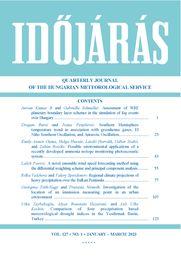IDŐJÁRÁS - angol nyelvű folyóirat
Vol. 127, No. 1 * Pages 1–142 * January - March 2023
 |
|
 letöltés [pdf: 5762 KB]
letöltés [pdf: 5762 KB]
Southern Hemisphere temperature trend in association with greenhouse gases, El Niño Southern Oscillation, and Antarctic Oscillation
Dragan Burić and Ivana Penjišević
DOI:10.28974/idojaras.2023.1.2 (pp. 23–42)
Dragan Burić and Ivana Penjišević
DOI:10.28974/idojaras.2023.1.2 (pp. 23–42)
IDŐJÁRÁS folyóirat

Az IDŐJÁRÁS a HungaroMet Nonprofit Zrt. negyedévenként megjelenő angol nyelvű folyóirata
Megrendelhető a journal.idojaras@met.hu címen.
A szerzőknek szánt útmutató itt olvasható.
Megrendelhető a journal.idojaras@met.hu címen.
A szerzőknek szánt útmutató itt olvasható.









